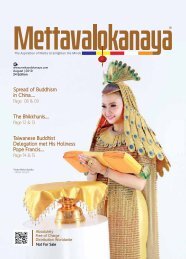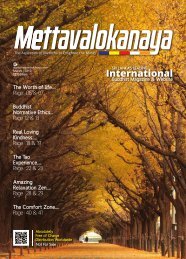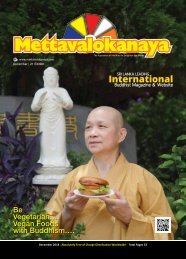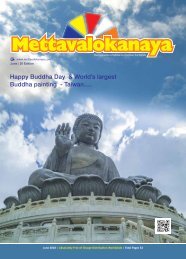Mettavalokanaya_Magazine_October_2017
“Mettavalokanaya” International Buddhist Magazine has been successfully distributed to 40 countries including all districts across Sri Lanka and now “Mettavalokanaya” is Sri Lankan Most Popular & Leading monthly Buddhist Magazine.
“Mettavalokanaya” International Buddhist Magazine has been successfully distributed to 40 countries including all districts across Sri Lanka and now “Mettavalokanaya” is Sri Lankan Most Popular & Leading monthly Buddhist Magazine.
Create successful ePaper yourself
Turn your PDF publications into a flip-book with our unique Google optimized e-Paper software.
The life of ethics and spirituality….<br />
Venerable Dr.Galle Uditha Thero<br />
The Chief Sangha Nayaka of Singapore & Chief Incumbent of the Buddhist Maha Vihara,<br />
in Singapore, The Lecture of Singapore Buddhist & Pali University, The Director of<br />
Wijayananda Buddhist Training Institute, Dharshana Visharada<br />
The Birth is<br />
pain, old age is<br />
pain, sickness<br />
is pain and<br />
death is pain….<br />
According to the “Dhammapada Pali” - Yamaka Vagga<br />
- The Twin Verses, “Subhanupassin viharantan - indriyesu<br />
asanvutan - Bhojanamhi amattannum - kusitan<br />
hinaviriyan - Tan ve pasahati maro - vato rukkhan va dubbalan”<br />
Whoever gives in to sense objects, unrestrained, immoderate<br />
in eating, lazy and idle, Mara will overthrow him as the wind<br />
pulls down a weak tree.<br />
Buddhism is a path for transforming the mind, for going<br />
from ignorance to wisdom, from self-centeredness to altruism<br />
and compassion. The mind is the source of all happiness and<br />
it is also the source of the experience of suffering. Buddhism<br />
offers methods to free the mind from delusion and harmful<br />
mental states such as hatred, obsession, jealousy, and pride.<br />
The Buddhist teachings are very vast and encompass both<br />
philosophical views and spiritual practice aimed at dispelling<br />
an erroneous view of reality and uprooting the very causes of<br />
suffering.<br />
Teachings of Buddha….<br />
The religion of Buddha is famous as Buddhism. The<br />
followers of that religion are known as Buddhists. In his<br />
teachings, Buddha showed a new path. In his religious<br />
mission, he did not give value to the so-called sacred rites<br />
and rituals. Instead, he showed the way for a life of ethics<br />
and spirituality. He preached in simple language and to the<br />
common people. He preached against the extreme means of<br />
worldly life which led to man’s self-indulgence, pleasures and<br />
unending desires. At the same time, he did not prescribe for<br />
the common man extreme hardship of ascetic life by physical<br />
punishment and self-torture. His was the noble ‘Middle Path’<br />
which was possible for every man to follow. Between the two<br />
extremes of pleasures and penance, he showed the path of a<br />
really virtuous life.<br />
The following main doctrines constitute the substance<br />
of his teachings:<br />
The Four Noble Truths or the Arya Satya….<br />
In his enlightenment, Buddha discovered the real causes<br />
of the miseries of human existence. He also discovered the<br />
way to escape from those miseries which followed endlessly<br />
in the wheel of Karma, birth and rebirth. These discoveries<br />
were called the Four Noble Truths.<br />
The first truth was the Truth of Pain or Sorrow. “Birth<br />
is pain, old age is pain, sickness is pain, death is pain.” felt<br />
Buddha. Everything in the world was transient, sorrowful and<br />
full of pain. The existence of this sorrow was in the nature of<br />
life.<br />
The second truth, according to Buddha, was the Truth<br />
of the Cause of Pain or Sorrow. This cause was the Desire. The<br />
desire or the Trishna was the lust and the thirst for all worldly<br />
things. It was the root of all evils leading to pain.<br />
The third truth was the Truth to end the Pain or Sorrow.<br />
This end or cessation of pain was possible by ending desires.<br />
Elimination of desires was to lead to the end of sorrows. Perfect<br />
bliss was to follow the end of the sorrows. It was like the end<br />
of life and death. It was the real freedom or emancipation.<br />
The fourth truth was the Truth to End the Desires. This<br />
was possible by a noble way to attain the real bliss without<br />
desires. Extreme penance was not necessary for this, while<br />
extreme pleasure was unnecessary by all means. Avoiding<br />
both, it was the noble middle path which was the right way<br />
to end the Desires. This path was to lead to the real state of<br />
freedom or emancipation. Buddha described this path as the<br />
Arya Astangika Marga or the Noble Eight-fold, path. This Path<br />
was the real path to end the cycle of Karma and the rebirth.<br />
The Noble Eight-fold Path….<br />
Buddha gave eight principles to follow as his noble<br />
eight-fold path. They were: the Right Vision, Right Aims, Right<br />
Speech, Right Action, Right Livelihood, Right Efforts, Right<br />
Mindfulness, and Right Meditation.<br />
The Noble Eight-fold Path was thus a code of conduct for<br />
every man. It became the basis of Buddhism as a religion. It<br />
was a religion for social happiness of all. Buddhism has been<br />
rightly described as ‘the most social of religions’.<br />
46 I <strong>Mettavalokanaya</strong> I <strong>October</strong> I <strong>2017</strong> I www.meththawalokanaya.com<br />
www.meththawalokanaya.com I <strong>2017</strong> I <strong>October</strong> I <strong>Mettavalokanaya</strong> I 47

















